|
Monogram's 1/72 scale
F-82 Twin Mustang
by Mark Davies
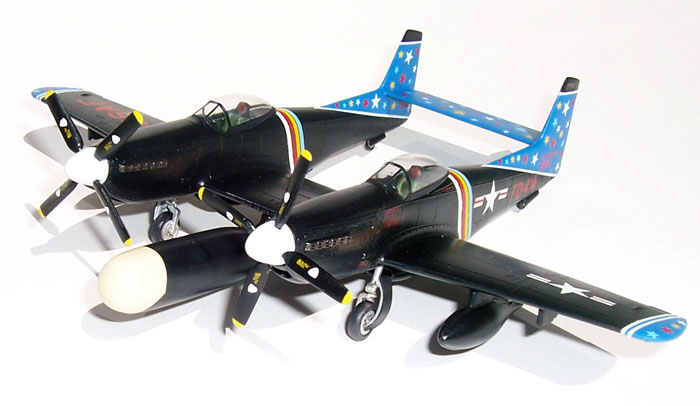
|
North American F-82 Twin Mustang |

Trumpeter's 1/72 scale Wellington GR.XIV is available online from Squadron.com
Background
The F-82 Twin Mustang came about to meet the need for a very long range escort fighter with performance on par with current single seats designs. At the time the longest ranged USAAF fighters were the P-38 Lightning and P-51D Mustang with ranges in the order of 2,000 miles. What was needed was a range of around 3,500 miles in order to escort long range bombing missions against Japan.
North American opted for the twin-Mustang design to provide a twin engine airframe without the additional of drag of two engine nacelles and one fuselage as per most conventional twins, or fuselage nacelle and two fuselages as with the P-38. It also had the benefit of providing for a second pilot to help cope with the lengthy missions envisaged (although the starboard second pilot’s cockpit only had basic flight instrumentation).
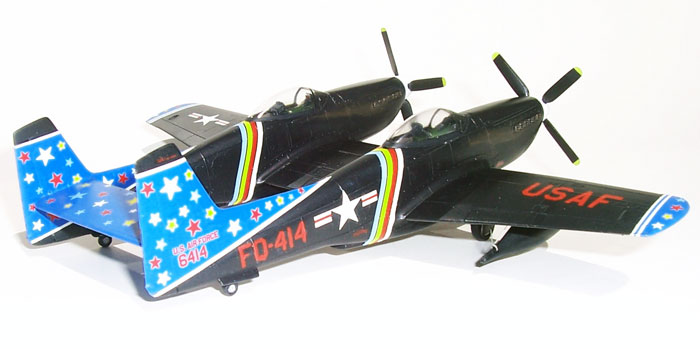
The design was based on the prototype P-51F Lightweight Mustang (the F variant was to give rise to the post-war production P-51H). An additional fuselage section 57” long was inserted behind the cockpits to cater for additional fuel tanks and other equipment. The P-51F’s wing panels were used without the gun bays for the outer wings, and new wing and tail centre sections were incorporated. The wing centre section carried the gun armament. Hard points for 4,000 lbs. of underwing ordinance plus rocket launchers were also installed. With four 110-gallon drop-tanks P-82A had a range of over 3,400 miles, and its top speed was some 30-mph faster than a P-51D at 468 mph.
The P-82 did not see service in WW2, and post-war it became the F-82. Its initial Packard Merlin engines were replaced ion later versions with Allisons because the USAF did not wish to pay US$6,0000 licence fee to Rolls Royce for each Merlin produced. The Allison engine proved less reliable than the Merlin, and often had to have all spark plugs changed after each flight due to fouling.
The F-82 was mainly used as an all-weather interceptor and intruder. The use of a long bulbous radome ensured the radar scanned ahead of any interference from the twin props. The F-82 saw useful service in the Korean War but was phased out of service in favour of later jet types.
The Kit
The 1/72 scale Monogram kit of the F-82 is an old one, and was one of the first Mongram kit I acquired when returning to the hobby about 12 years ago (prior to that mine was mainly a childhood experience of Airfix, Revell GB and Frog kits). I have seen a another kit of the F-82 which I recall looked like an inferior copy of the Monogram kit - I think it was Hobbycraft or possibly Kitech brand.
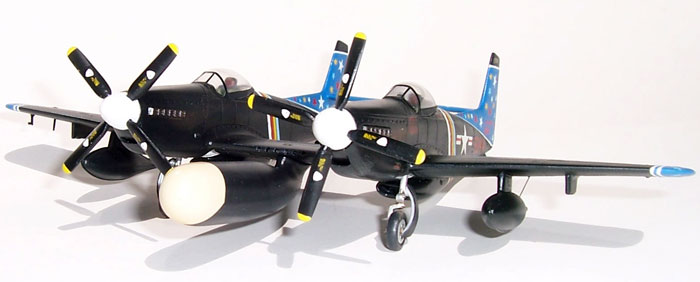
The kit is quite crisply moulded with fairly prominent raised surface detail. Although a bit basic the cockpit interiors are probably better than many from 1960’s and 70’s. They have smooth instrument panels for instrumentation decals, gun sight, floors and seats, some radio gear behind the head armour, control columns and faintly raised outlines on the fuselage sidewalls which can be made to stand out with careful painting. Main wheel well detail is above average and the six-.50 cal Brownings with their ammo supply can be displayed under a removable panel in the centre wing section.
The worst part of the kit is the unrealistic and slightly cumbersome mechanism to enable the canopies to slide open. Added to this are rather thick, and in my case slightly discoloured clear plastic (plus a cracked windscreen as it happens).
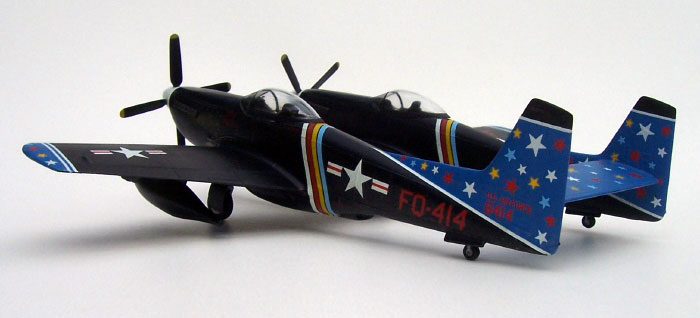
I can’t comment on the kit’s decals, as mine was second hand kit without them. But generally in my experience old Monogram decals look dreadful and I have never used any. The instructions were quite adequate for the task of completing the kit, which included the option of no radome and Christmas tree rocket launchers and rockets, as well as two drop-tanks.
I’d waited a long time to build this kit, and had originally planned to put a lot of effort into it. However I was being pushed for time on a twin-engine group build I was participating in. I was building a Trumpeter Wellington GR XIV for this but was concerned I would not finish on time, and needed a quick-build twin as a back-up project.
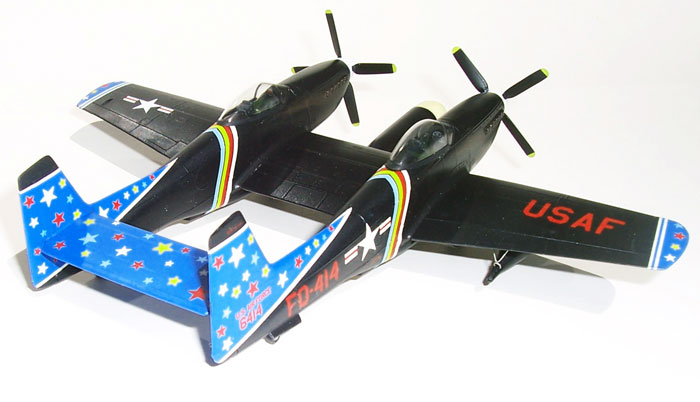
I had a look through my stash for an interesting and simple to build twin-engine job I could sling together quickly. The Monogram F-82 seemed a good subject, as it was simple to build, and would need just one overall colour. The decider was that I had some Falcon Canopies and Super Scale decals with a colourful markings option.
I ran with the kit cockpit interiors but made two radarscope hoods for the 2nd pilot, and used the Super Scale instrument decals. Some AML PE set belts were added to dress the seats, and the slots for the sliding canopies were filled in. Assembly was a breeze with the fit of parts being generally very good. The only tricky fits I found were the very front of the fuselages where the props mount. Here the kit has an insert for the prop to mount in that also forms the upper part of the nose intakes, and the fit was a bit indifferent. Also the prop spinners and their base plates needed some fairing in with filler. The Falcon canopies were easily dealt with and were a definite improvement over the kit items. The decals proved good to use despite some fairly large pieces (the medium blue under the stars is part of the decal).
This was a rushed build and an even more rushed paintjob. As it happens I finished my Wellington in time for my group build. As things stand the kit probably deserved a less rushed and more focussed effort, but it looks ok in the middle of one of my display cabinets.
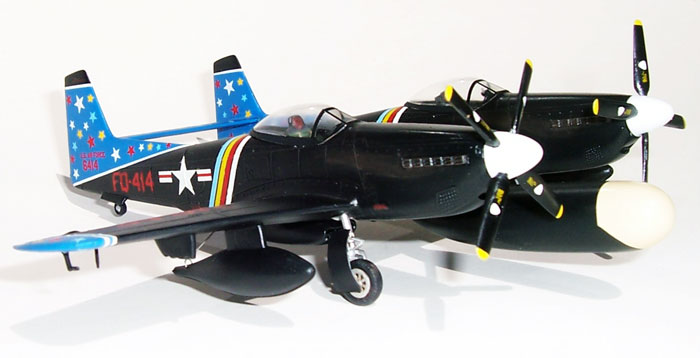
Still the best 1/72 kit of the F-82, I’m sure the Monogram kit could be built into something really good with some extra effort.
Models, Description and Images Copyright © 2010 by Mark Davies
Page Created 5 May, 2010
Last Updated
5 May, 2010
Back to HyperScale
Main Page

|
Home
| What's New |
Features |
Gallery |
Reviews |
Reference |
Forum |
Search